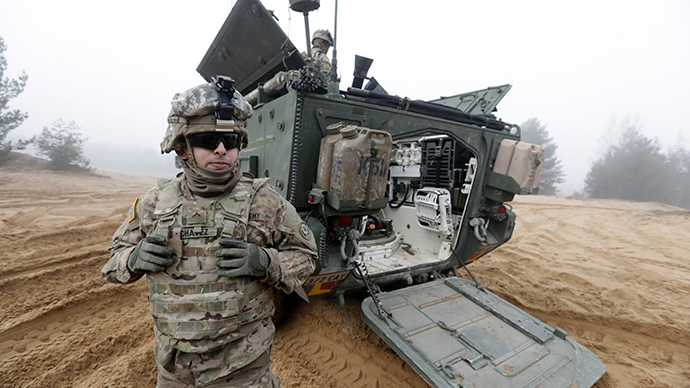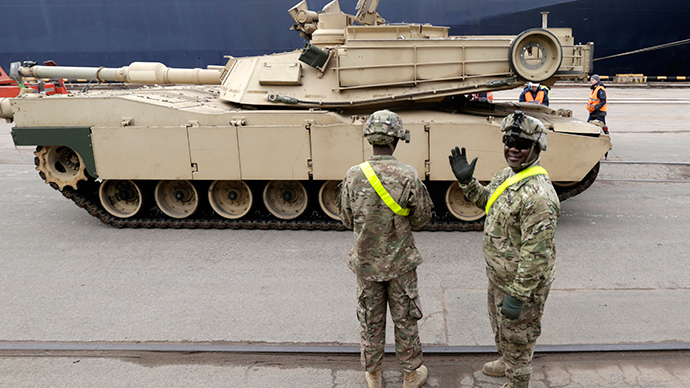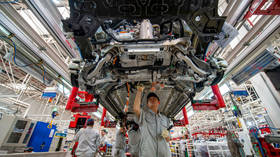‘US seeks to drive wedge between Europe & Russia’

The purpose of NATO exercises on Russian borders is to ratchet up the tension with Moscow and to put Russia ever further on the back foot, says John Laughland of the Institute of Democracy and Cooperation in Paris.
The US has sent around 750 military armored vehicles and a thousand troops to Latvia as part of a multinational training mission with NATO partners. US Army General John O’Conner said the move will “deter Russian aggression.”
READ MORE: Over 100 US armored vehicles roll into Latvia, NATO flexes muscles in Europe (VIDEO)
RT:These massive NATO exercises on Russia's borders are being justified by a perceived threat of an invasion. Is that a real threat?
John Laughland: Of course not, [Russia] is not a threat to NATO countries; it is not a threat to any of its other neighbors. The purpose of these things is to ratchet up the tension with Russia to keep applying more and more aggressive initiatives, to put Russia ever further on the back foot.
RT:So what is the endgame?
JL: The endgame is to reinforce the Western block of the European Union and the transatlantic relationship. That is the endgame. The purpose is to drive the wedge between the countries of Central and Western Europe and Eastern Europe on the one hand and Russia on the other, with the goal of creating a transatlantic political and economic unit underpinned by the existing North Atlantic Treaty Organization [NATO].

RT:Where would the border be between that and Russia?
JL: …It would in their idea, in their plans to include Ukraine. In other words it would go along the Ukrainian- Russian border. For the time being Ukraine of course doesn’t belong to NATO. It is clear that it wanted to join NATO.
RT:Moscow says the US-led maneuvers are bad for dialogue. What's NATO expecting to achieve? What is Minsk about?
JL: The Western powers have never been interested in peace processes. What they are interested in is victory. … The point about Minsk is that France and Germany have a slightly, and I emphasize, slightly different perception from Washington, London, and Brussels, the NATO headquarters. France and Germany are to some extent trying to find a peace agreement. But they are being fought by the Americans and by the British, to put it very simply.
And indeed within the US there are also battles going on between, on the one hand, Obama who is more dovish but more relatively isolated, and the Congress which is very belligerent. So there are battles going on within the Western block. These latest movements are in a sense designed by the hawks within the Western block, both in Europe and in America, to do down the people who are being more dovish.
RT:Is the European public really buying this idea that Moscow is a “huge threat to NATO”? How taken-in is the Western public by this scare-mongering by officials and the media?
READ MORE: US armor paraded 300m from Russian border (VIDEO)
JL: It is not entirely a new idea. On the contrary, that is an idea that has been around for a very long time. … It has been re-launched by Jean-Claude Juncker, the President of the European Commission. What was interesting when he re-launched this idea in the interview with Die Welt on Sunday is that he said specifically that it was designed to defend Europe against Russia and to show that Europe was determined to protect its values against Russia.
This is why I say that the endgame in all this is to reinforce the existing supranational institutions of the West – the European Union, on the one hand, and the transatlantic bond on the other. There is no doubt that European officials themselves are 100 percent behind this. They want Russia to be the enemy because they think it will give legitimacy to their project - union. Whether the public buys it - that is a difficult question to answer; you have to do an opinion poll or hold an election.
The statements, views and opinions expressed in this column are solely those of the author and do not necessarily represent those of RT.
The statements, views and opinions expressed in this column are solely those of the author and do not necessarily represent those of RT.












